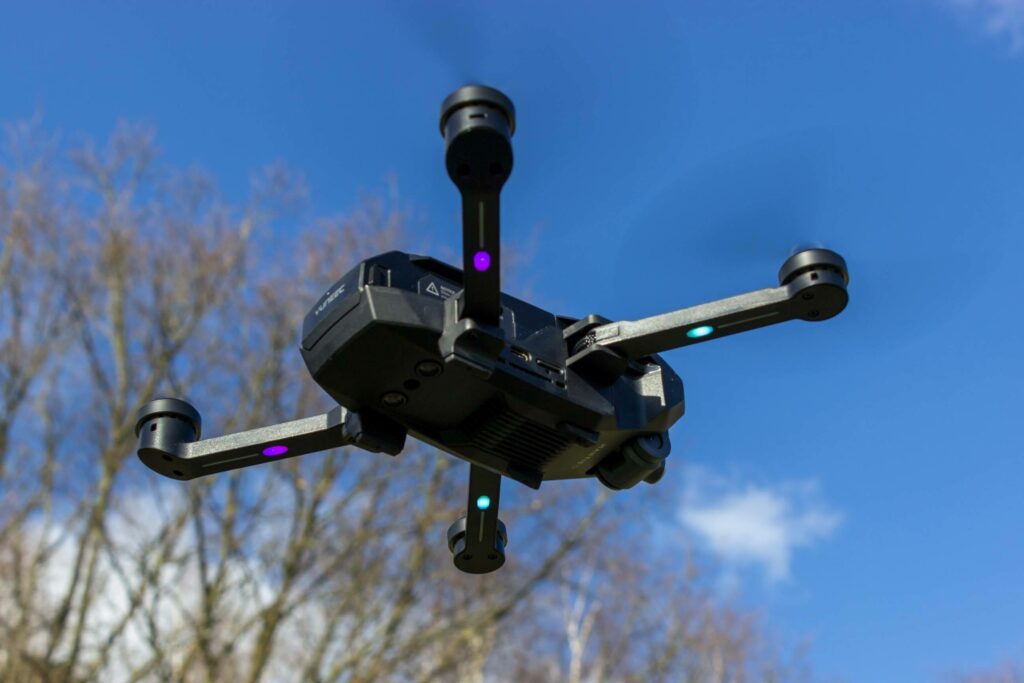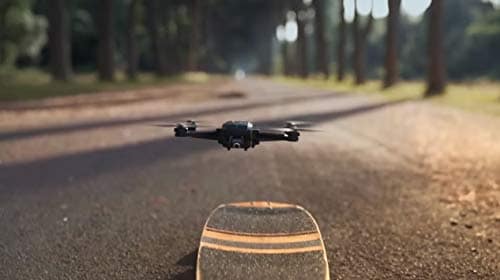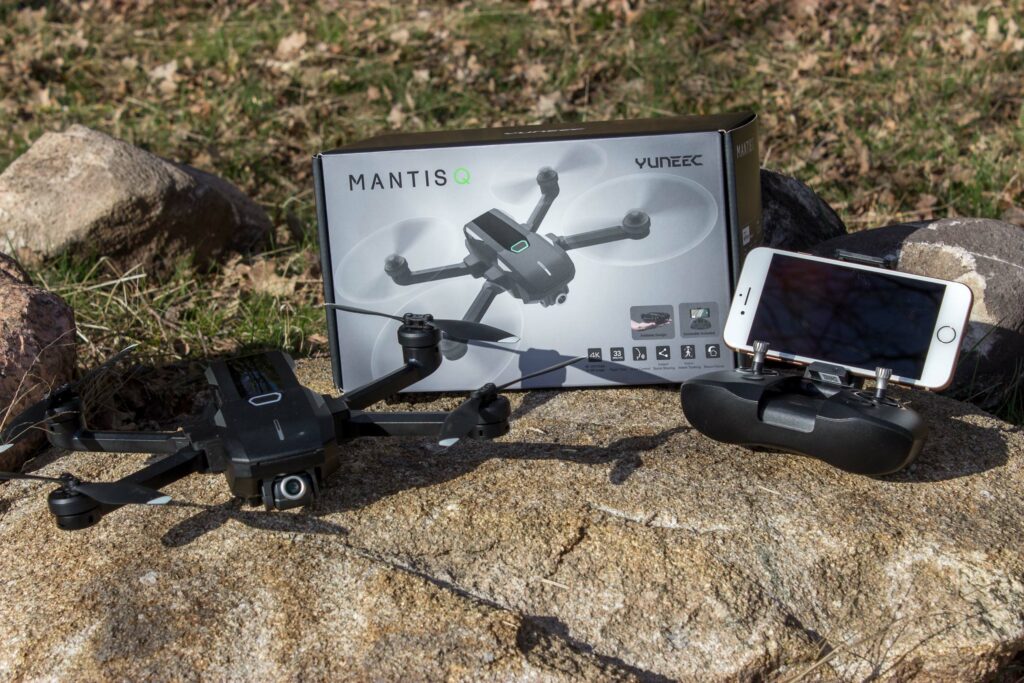Yuneec Mantis Q – What can the compact 4K quadcopter do?
The Yuneec Mantis Q is a foldable drone with 4K camera. Thanks to its compact dimensions, this handy quadcopter is your ideal companion on the road or while traveling.
We took a close look at the Mantis Q and tested the different modes and settings in detail. Have fun with our experience report!
The most important at a glance
When you unpack the Yuneec Mantis Q for the first time, you immediately notice its compact dimensions. When folded, the copter measures just 168 x 96 x 58 mm. Together with the low weight of about 480 g, the drone is therefore perfect to take it everywhere.
Visually, the compact quadcopter is reminiscent of the DJI Mavic Pro, but is significantly smaller and lighter in comparison.
The quadcopter is controlled with the handy controller. All other commands are given to the drone via the free Yuneec Pilot app.
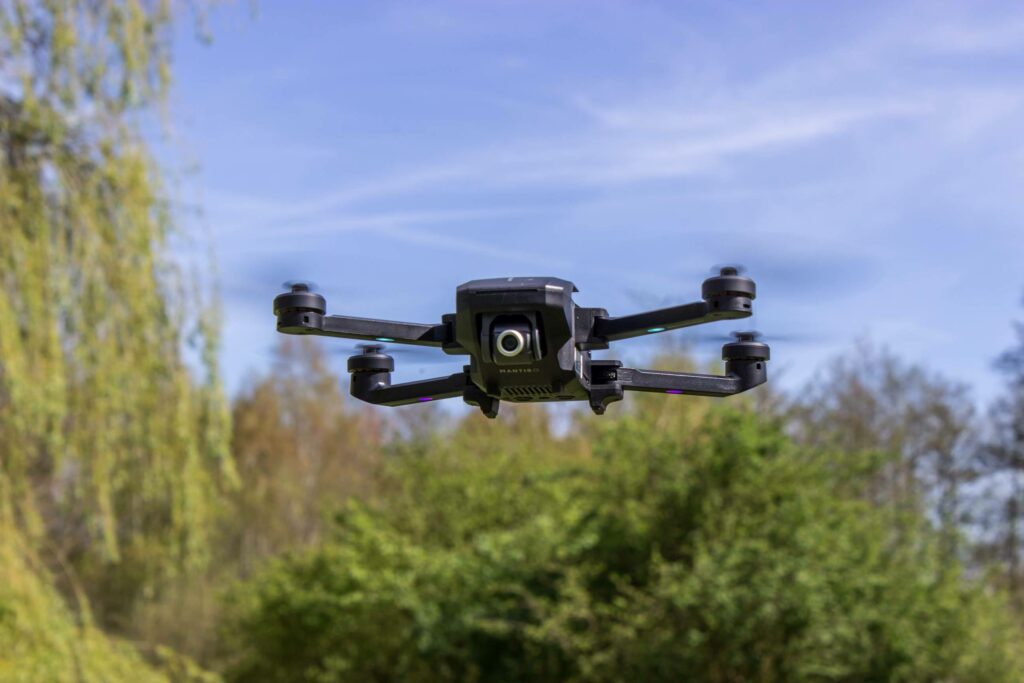
According to Yuneec, the copter can fly for up to 33 minutes on one battery charge (windless, at 15.5 mph or 25 km/h). In our test flights, we achieved times between 22 and 30 minutes, depending on photo/video usage and selected flight mode.
Tip: In the X-Pack version, the drone comes with a total of 3 batteries. This gives you a combined flight time of about one and a half hours!
In Sport mode, the Mantis Q reaches speeds of up to 44.7 mph (72 km/h) and can be controlled extremely agilely. For taking photos and videos, however, it’s better to switch to the slower Angle mode.
The 4K camera of the Yuneec Mantis Q can be swiveled in one axis (vertically), but the copter unfortunately does not have a freely rotatable gimbal. The drone records videos in 4K or Full HD. However, the electronic image stabilization only works for Full HD recordings. Therefore, recording UHD material is only recommended to a limited extent.

Yuneec specifies a range of 875 yards (800 meters) for the drone. That is sufficient, especially since drones are still only allowed to be flown on sight in many countries. According to Yuneec, the image transmission range is 547 yards (500 meters). However, we experienced the first connection problems after about 330 yards (300 meters) and the transmission hooked a bit.
The Mantis Q has four automatic flight modes: Follow-Me, Watch-Me, Point of Interest (POI) and Journey.
A Return Home (RTH) function is also available. Unfortunately, there is no collision protection (obstacle detection). However, there is a voice control with a large number of commands.
Equipment & scope of delivery of the Yuneec Mantis Q
The Mantis Q is available in two different versions. In the X-Pack version, the copter comes with two extra batteries and a practical photo bag.
In addition to the copter and the remote control, the standard version includes: a battery (3S, 2800 mAh LiPo), charger, USB-C cable, a 16 GB microSD card, an instruction manual and 4 spare rotors.
It takes about 60 minutes to charge the battery. The serial 3-port charger can charge three LiPos in a row. The controller takes about 90 minutes for a full charge, but will last for several battery charges of the drone.
The instruction manual is easy to understand and leaves no questions unanswered. The Yuneec Pilot app is available for free.
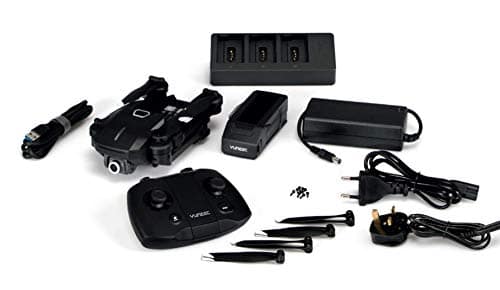
Thanks to the built-in IPS (Indoor Positioning System) with two small ultrasonic sensors on the bottom, the Mantis Q can maintain altitude and position even indoors without GPS. However, the speed for indoor flights is limited to a maximum of 9.3 mph (15 km/h).
Scope of delivery
- Copter with integrated camera (4K, 60 fps)
- Remote control
- 1 x LiPo (3S, 2800 mAh)
- Charger with power supply
- USB-C cable
- 4 spare rotors
- 16 GB microSD card + adapter
- Instruction manual
- 2 spare batteries (only in X-Pack version)
- Carrying case (only in X-Pack version)
If the 16 GB memory card is not enough, you can use your own SD cards up to Class 10 or U3 128 GB.
Controller & Yuneec Pilot App

First, install the free Yuneec Pilot app on your smartphone.
Then attach your smartphone to the remote control and launch the app. Follow the instructions on the display and establish the connection with the controller and drone. You’re ready to go!
The app’s user interface is clearly designed and provides a lot of important information at a glance.
At the top of the screen, the current flight mode, number of connected satellites and the battery status of the controller and drone are displayed. Just below that are the current camera settings (ISO, shutter, EV).
With the icons on the left side, you can start the drone, switch to the different auto-flight modes or initiate the return flight via touch command. By the way, there is also a separate button on the controller for this function (RTH). Distance, altitude, speed and previous flight duration are shown at the bottom of the display. A small map also shows the current as well as the start position of the drone.
Photos and videos can also be taken either via button (shoulder buttons) or touch command. The photo and video settings for ISO, shutter speed, resolution, image formats and much more are also easily accessible. The gear icon at the very top right opens three more tabs with all sorts of settings options. Here you can, among other things, set the desired altitude (65 to 1640 feet or 20 – 500 m) at which the Mantis Q should return to you in RTH mode. Preset here are 394 feet (120 m).
Compass calibration as well as settings for the LEDs and voice control can also be found here. “Wake up”, “Start”, “Video”, “Stop”, “Photo”, “Selfie” and “Landing” are just some of the commands you can use to remotely control the Mantis Q via voice command. You can find a list of all voice commands in the settings of the Yuneec Pilot app by clicking on the “i” next to the menu item “Voice Control”.
The last settings tab hides settings for video cache, unit system (metric/imperial), and resetting to factory settings. By the way, those who want to limit the range of their drone can do so with the help of the practical geo-fencing function.
At a battery level of 20%, the Mantis Q independently switches to RTH mode and automatically returns to the launch position. If you want, you can deactivate this function in the settings.
Flight characteristics, flight modes
Once the Mantis Q is in the air, you immediately notice its sportiness and agility. The four brushless motors accelerate the copter in Sport mode up to 44.7 mph (72 km/h) and enable agile flight maneuvers. The climb speed is up to 8.7 mph (14 km/h), the descent speed up to 6.8 mph (11 km/h).
Angle mode is a bit more leisurely, with speeds of up to 13.4 mph (21.6 km/h). This mode is therefore recommended primarily for taking photos and videos, as well as for initially familiarizing oneself with the controls.
We could not quite reach Yuneec’s stated flight time of 33 minutes during our test flights. Without photo or video recording, and when used in Angle mode, we still achieved a flight time of just over 30 minutes. With excessive camera use and operation in Sport mode, we still managed 22 minutes of flight time. This is also an excellent value in this price range.
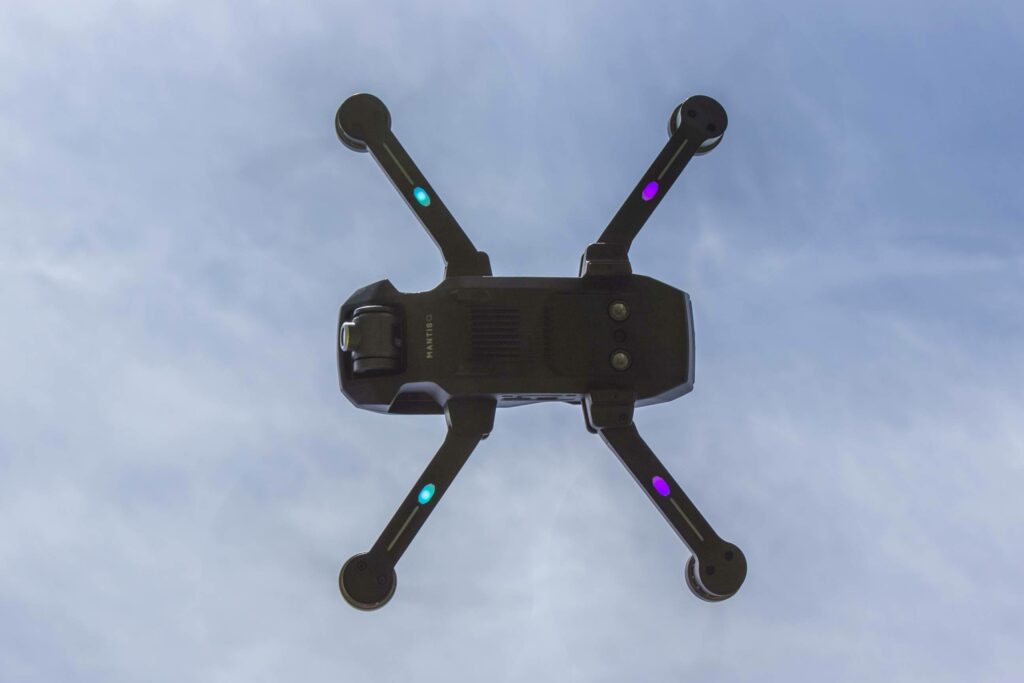
Without control commands, the Yuneec Mantis Q hovers pretty accurately on the spot thanks to gyroscope, GPS and GLONASS. However, you should not fly with the Mantis Q in too much wind. The copter clearly drifts to the side, is difficult to control and is only of limited use for video recordings.
Thanks to the two built-in ultrasonic sensors on the bottom, you can fly the Mantis Q indoors without GPS reception. The pure flying was great fun for us. Not only the agility in Sport mode, but also the long battery life convinced us.
Another plus point is the flight software used. It is based on the open source project PX4, is extremely stable and reliable, and does not send video, photo, or telemetry data to third-party servers.
The Auto Flight Modes
With the help of the four auto-flight modes, interesting camera movements can be realized and beautiful shots can be taken easily.
Follow Me: In this mode, the drone follows you wherever you go.
Watch Me: The Mantis Q hovers on the spot, but doesn’t let you out of its sight.
Point of Interest: The copter circles a freestanding object. Perimeter and speed are adjustable.
Journey: On an imaginary line, the drone moves away from you and returns. Distance and speed are adjustable.
The camera

The integrated camera has a 1/3.06 inch CMOS sensor. Video recordings up to Full HD are electronically 3-axis stabilized (EIS system). Photos are recorded in up to 13 MP. You can choose between three different video resolutions: 4K: 3840 x 2160 @ 30fps; 1080p: 1920 x 1080 @30fps (with image stabilization) and 720p: 1280 x 720 @60fps (with image stabilization).
The built-in wide-angle lens has a field of view (FOV) of 117°. Spot, center and average metering can be selected for focusing. Videos are saved as MP4/MOV, photos as JPG and DNG. ISO settings range from 100 – 3200, and exposure compensation is up to +- 3 stops. Shutter time ranges from 8 s – 1/8000 s for photos and 1/30 s – 1/8000 s for videos.
The live image from the drone is transferred to the user’s smartphone with a latency of less than 200 ms.
Recording quality
Since the integrated camera can only be panned vertically, there are some limitations for video recordings. For example, the entire drone must be rotated once around itself for a 360° pan. This naturally leads to more unsteady recordings than if a full-fledged gimbal were available, as is the case with the Yuneec Typhoon H Plus, for example.
The lack of a gimbal is also noticeable when accelerating and braking while filming. Abrupt control commands clearly affect the recordings, despite stabilization of the camera image.
The Yuneec Mantis Q’s electronic image stabilization works up to 1080p resolution and delivers much smoother results compared to 4K recordings. Nevertheless, we are not convinced by the system’s performance without exception, because even the stabilized recordings are not completely smooth – which is probably bearable for hobby pilots, but might be an argument against buying the Mantis Q for ambitious drone filmmakers.
The quality of the photos, on the other hand, surprised us positively. Most of the snapshots looked very decent even unedited. Thanks to the option of recording photos in DNG format, the pictures can be easily edited later on.
Conclusion
The Mantis Q from Yuneec is an ultra-compact, foldable drone with long flight time. The small dimensions and low weight make it the ideal companion for on the road or when traveling. Thanks to various auto-flight modes, even beginners succeed in taking spectacular pictures. The Sport mode (max. 44.7 mph or 72 km/h) ensures great flying fun and thanks to ultrasonic sensors, the copter can also be used indoors. In the X-Pack, the Mantis Q contains a total of three batteries in addition to a practical bag, which brings it to almost 100 minutes of flight time.
While the quality of the photos is very solid, the video results cannot fully convince. The electronic image stabilization only works up to Full HD and even then not quite perfectly. Together with the significantly lower price of under $500, in contrast to the DJI Mavic Pro, the Mantis Q is therefore aimed more at drone beginners than ambitious videographers. If you only want to create high-quality videos, you should rather go for a drone with a camera with a full-fledged gimbal. On the other hand, if you mainly want to take snapshots and selfies and are looking for a small and extremely powerful copter with a long flight time, the Yuneec Mantis Q is the perfect choice.
